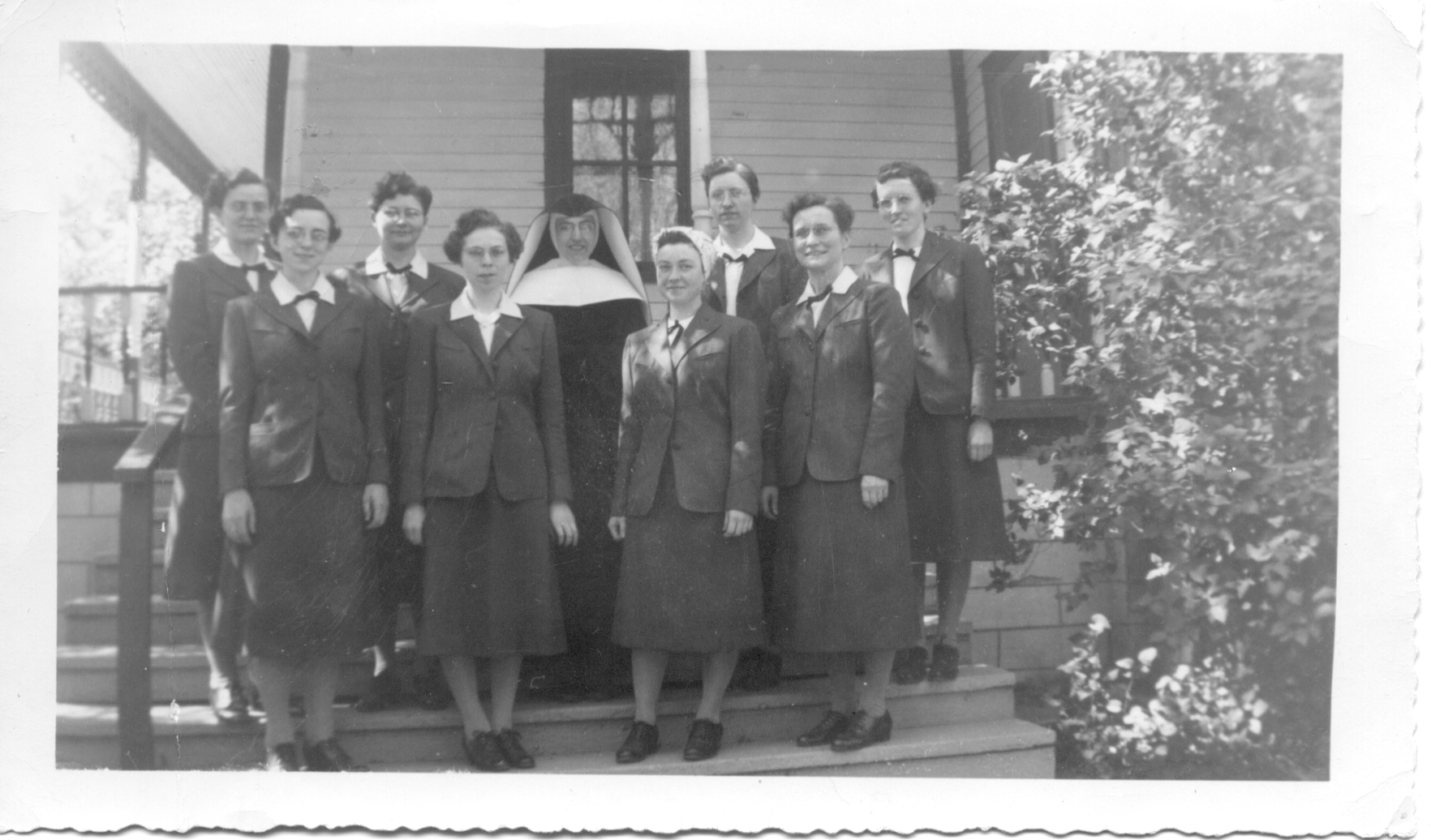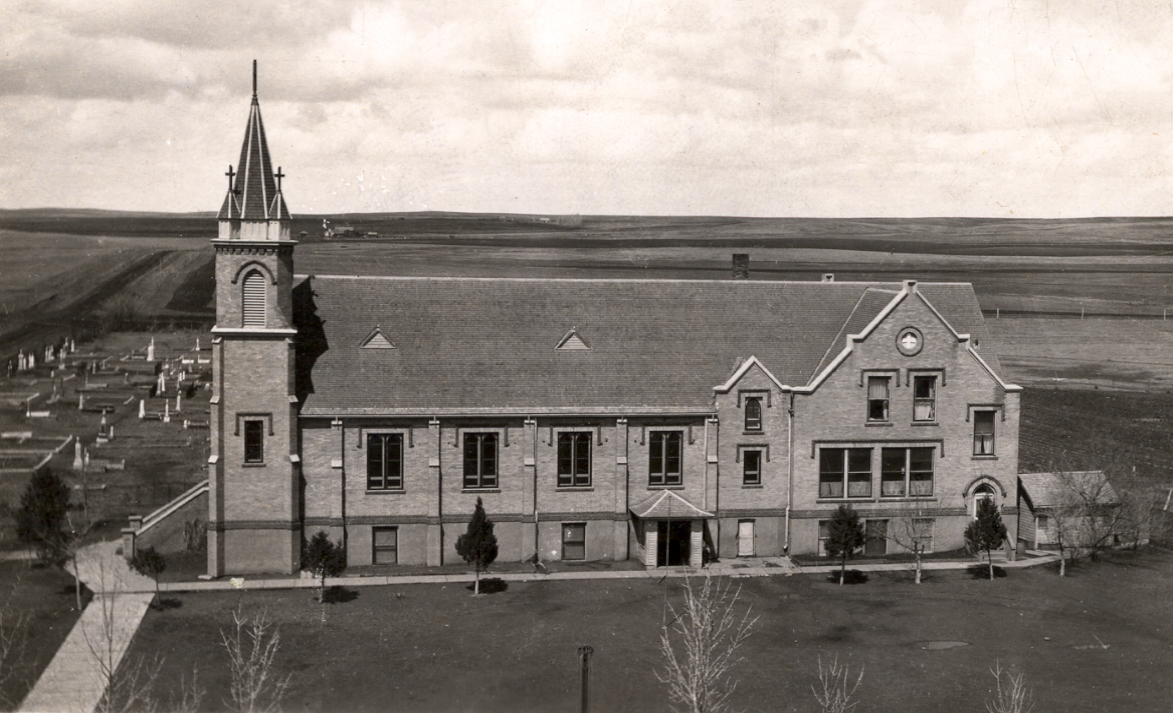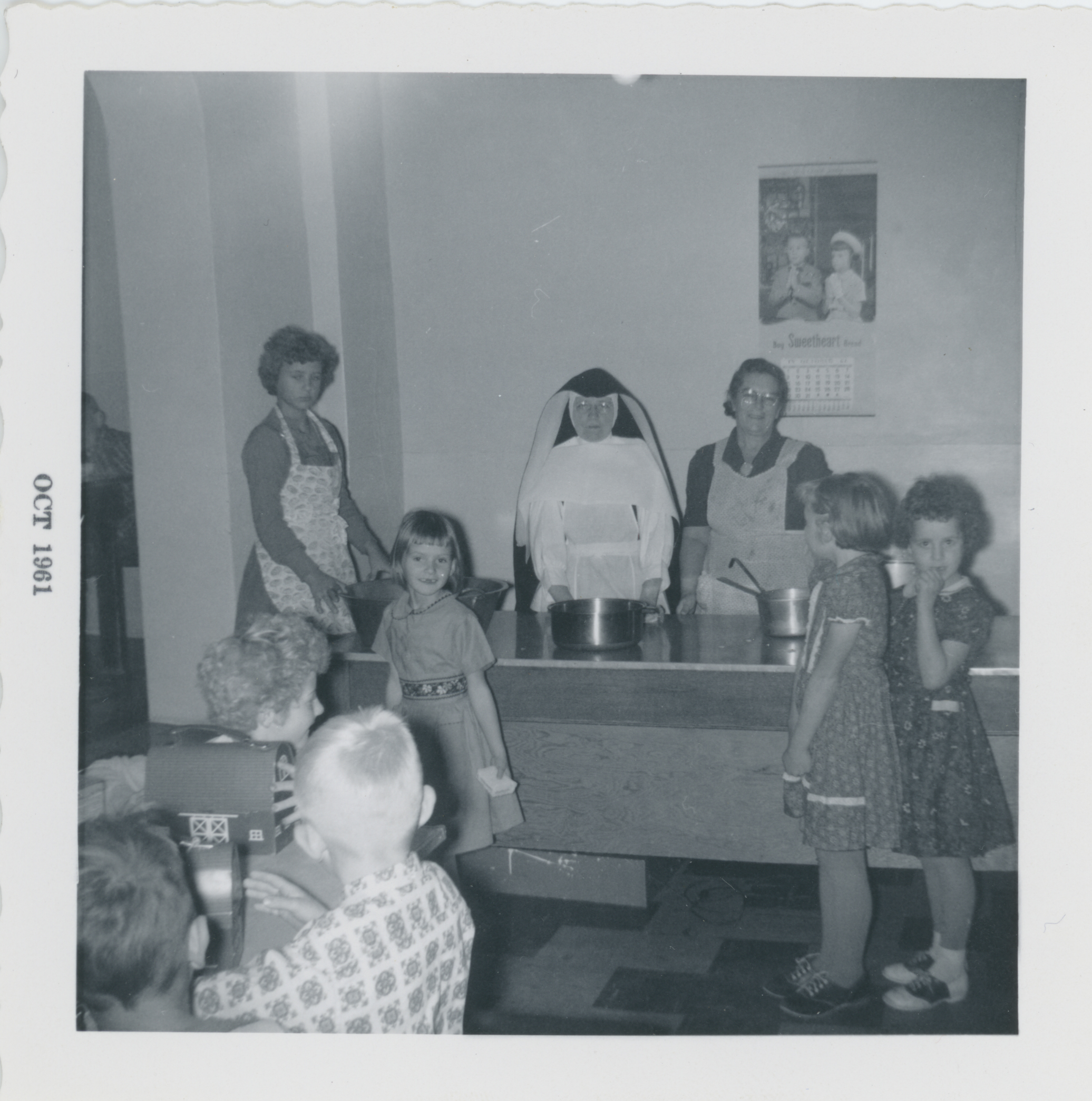The School Sisters of Notre Dame (SSND) celebrated 100 years in the Diocese of Bismarck, North Dakota.
In 1847, SSND came to the United States. In 1865, the first sisters arrived in Mankato, Minnesota, and in 1912, the province was established. After repeated appeals from Bismarck North Dakota’s Bishop Vincent Wehrle, for teachers in schools in North Dakota, Mother Isidore, Mankato’s first provincial superior, opened schools in New Hradec and Scheffield in 1917. In the years that followed, the sisters answered the call to teach at many other schools in North Dakota.
When the sisters arrived at each location, especially in the early 1900s, they were greeted by the harsh prairie weather and lacked necessities. They taught, cared for boarders, raised livestock and planted a garden to provide food for themselves and the boarders.
 Many of the schools underwent changes when on June 29, 1948, North Dakota voters passed the Anti-Garb Law, prohibiting Catholic sisters from wearing their habits while teaching in a parish school that had a public school status. This drastically changed the role and influence of SSND in these schools.
Many of the schools underwent changes when on June 29, 1948, North Dakota voters passed the Anti-Garb Law, prohibiting Catholic sisters from wearing their habits while teaching in a parish school that had a public school status. This drastically changed the role and influence of SSND in these schools.
Over the course of 100-years, SSNDs have worked diligently to serve the communities where they were sent. Below you will find a list of 12 North Dakota schools where SSNDs taught. SSNDs still serve at two of the 12 schools.
-Written by: By Sister Ann Schoch, SSND
Select a location below to learn more.
SS. PETER AND PAUL, NEW HRADEC: 1917-1969
On December 20, 1917, four SSNDs arrived in New Hradec, North Dakota, a town with only one building, the church. Bishop Wehrle was happy to greet the sisters who opened the school after New Year’s Day in the church basement with approximately 23 students, including two boarders. There were no books, desks or beds because of a blizzard that halted their delivery. Parents often made payment for tuition and boarding fees with meat, garden produce and even coal. The original building, with many alterations and additions, served all purposes for many years: a coal bin, a classroom and eventually a dormitory. Increased enrollment in January 1935, forced the upper grade classroom to become part of the public school district, providing the SSND teacher with a district salary. When only 70 students registered in 1967, the state inspector of schools recommended the public school classrooms return to parochial status, as the school was public in name only, and a parochial school operated on state funding. With the closing of the school year in 1969, the parish could no longer support a school and the sisters withdrew; 65 sisters had served at the first school in the diocese and in North Dakota.

ST. PIUS, SCHEFFIELD: 1918-1968
 Two weeks after SSNDs arrived in New Hradec, North Dakota, Mother Isidore brought four sisters to St. Pius Parish in Scheffield, North Dakota. A week later, 49 students, including nine boarders, appeared for class in the partitioned church hall. Within six months, the enrollment reached 110, and classrooms were added in the church basement. For the first 10 years, the sisters and boarders lived in crowded and impoverished conditions. Crop failures, as well as the 1924 tornado, prevented the community from building as they had initially planned. In 1928, with the best crop ever, the parish built a three-story brick school/convent. As a public school, they were able to add a high school in 1935, which operated until 1947. In 1968, the school district asked Monsignor Dahmus to operate one classroom as a public school to prevent the dissolution of the district. That same year SSNDs withdrew from the school. During the school’s 50-year existence, 80 sisters ministered at St. Pius.
Two weeks after SSNDs arrived in New Hradec, North Dakota, Mother Isidore brought four sisters to St. Pius Parish in Scheffield, North Dakota. A week later, 49 students, including nine boarders, appeared for class in the partitioned church hall. Within six months, the enrollment reached 110, and classrooms were added in the church basement. For the first 10 years, the sisters and boarders lived in crowded and impoverished conditions. Crop failures, as well as the 1924 tornado, prevented the community from building as they had initially planned. In 1928, with the best crop ever, the parish built a three-story brick school/convent. As a public school, they were able to add a high school in 1935, which operated until 1947. In 1968, the school district asked Monsignor Dahmus to operate one classroom as a public school to prevent the dissolution of the district. That same year SSNDs withdrew from the school. During the school’s 50-year existence, 80 sisters ministered at St. Pius.
ST. MARY, NEW ENGLAND: 1924-2000
St. Mary School was founded by Father Poettgens, who envisioned a parochial boarding school that would provide Catholic education to the children in New England, North Dakota and the surrounding area. He bought an unused hardware and grocery store and requested Mother Isidore send her sisters as teachers. She arrived in 1924 with eight sisters. School opened for 106 students, including 46 boarders. The school faced many challenges but gained a fine reputation for its education, sports and music. By November 1924, 80 music students comprised the orchestra that became a main attraction at civic and school activities. Native American students from reservations in North Dakota, South Dakota, and Montana enrolled. By 1927, with an enrollment increase, a high school was constructed and a dormitory was built out of a coal bin. In 1948, a new high school was built. The peak enrollment for both the high school and grade schools was in the 1950-1970 era. Later, the high school opened its doors to foreign students in an effort to increase enrollment, however, dwindling population, and escalating costs for upkeep of buildings and educational needs, forced the closing of St. Mary High School in 1992. With only 21 students, the grade school closed in 1997. The original hardware and grocery had served as a convent for 42 years and as the elementary school for 54 years. After 76 years of dedicated service by 226 sisters, the last SSNDs left in 2000.
ST. BENEDICT, STRASBURG: 1943-1998
In Strasburg, North Dakota, a wood-frame church built in 1893 by German-Russian Catholics was moved across the street in 1910 to make room for a new church. By 1912, it served as a convent for the Ursuline Sisters who, at the invitation of Bishop Wehrle, had arrived two years earlier from Switzerland to conduct classes in the new church basement. A new school was built in 1917, and in 1923, high school classes were added to the curriculum. Financial difficulties forced both schools to become part of the public school district in 1931. The Ursuline Sisters remained until 1943. Eight SSNDs arrived in Strasburg that summer. Enrollment increased and an addition was completed for a high school, allowing grade school expansion in the old building. Once the parish felt it could again afford to do so, the grade school reverted to its parochial status in 1959, and the high school in 1960. The two Catholic high schools in the area, St. Anthony of Linton, North Dakota, and St. Benedict of Strasburg, North Dakota, consolidated in 1966 as Emmons Central High School. Housed in the St. Benedict building, the school was staffed by four SSNDs, three Precious Blood Sisters and a diocesan priest as superintendent. With the withdrawal of SSND from Emmons Central in 1982, and from St. Benedict in 1989, another SSND came as parish minister and religious education teacher for Strasburg and St. Mary’s in Hague, North Dakota, and ministered there until 1998. SSNDs had 94 sisters serve in Strasburg. The famed band leader Lawrence Welk attended St. Benedict School during the time of the Ursuline Sisters. He was a faithful alumnus and remained a friend of the School Sisters of Notre Dame.
ST. WENCESLAUS / TRINITY ELEMENTARY EAST, DICKINSON: 1951-2008
Although the Bohemian parish of St. Wenceslaus was organized in 1912, no school existed in the parish until 1951. Appointed in December 1949, the pastor quickly made plans for St. Wenceslaus School. By August 1951, four SSND were welcomed to Dickinson, North Dakota, by the pastor, parishioners and Benedictine sisters who had established schools in the city. When enrollment reached 263 in 1957, construction began on a four-classroom addition to the school and lay teachers were hired to assist the sisters. The Dickinson parishes entered a consolidated school arrangement in 1968, placing students in one of the three elementary schools according to grade levels. By 1979, each of the three schools functioned as a kindergarten through grade six school, as all seventh and eighth graders had been moved to Trinity High School. St. Wenceslaus was under a lay principal and teachers from 1984 until 1991. The convent had been converted to a parish office complex. SSND returned to the school from 1991 until 1997, after which a Presentation Sister from Valley City came for three years. Beginning in 2000, all three elementary schools became part of the Dickinson Catholic Schools. St. Wenceslaus was administered by an SSND until 2008, and St. Wenceslaus was renamed Trinity Elementary East. For 57 years, 23 SSND were part of St. Wenceslaus/Trinity Elementary East, including a sister who ministered in the parish.
ST. JOSEPH, DICKINSON: 1981-2004
St. Joseph, the first school in Dickinson, North Dakota, started in the church basement in 1904 for 93 students between ages 14 and 16. Taught by three lay teachers, a large number of students were not able to read or write. Four Sisters of St. Benedict from St. Joseph, Minnesota, arrived in 1905 to serve these children of German immigrants. The first SSND came to St. Joseph Parish in 1981 as a pastoral minister. The following year, a SSND arrived as a special needs teacher and, in 1985, the first SSND administrator arrived. For 22 years, five SSND carried on the tradition of excellent education by the Benedictines and their lay staffs. Sister Gladys Reisenauer, SSND, taught at St. Joseph for 16 years, leaving in 2004 when the school closed after 100 years.
ST. ANNE, BISMARCK: 1957-1989 and ST. JOSEPH, BISMARCK: 1957-1973
The story of SSND coming to St. Anne and St. Joseph Schools in Bismarck, North Dakota, began in 1953, four years before the schools were built. Three priests from the diocese had made the trip to Mankato, Minnesota, to ask Mother Bernardia for sisters to serve at St. Mary’s High School. When told she could not help with high school teachers, they were quick to inquire about elementary teachers. Mother promised, “four in four years.” By 1957, St. Anne parishioners had built two schools roughly two miles apart, St. Anne on the west end of the parish and St. Joseph on the east end. That September, not four but six sisters arrived in Bismarck, North Dakota, to staff the schools for 307 students. The schools flourished and St. Joseph, became a primary school for fourth through sixth grades. By 1973, with changing times and decline in enrollment, there was sufficient space in St. Anne School for all the elementary students. After a brief existence as the primary school associated with St. Anne, St. Joseph school was closed. In 1989, the last two of the 20 SSND who taught at St. Anne School left.
ST. GERTRUDE HIGH SCHOOL, RALEIGH: 1959-1987
In 1906, five Catholic families of German-Russian descent settled in the area of Raleigh, North Dakota. The nearest Catholic church, 18 miles away, was in Porcupine, North Dakota. In 1913, with 28 Catholic families in the St. Gertrude area, five miles from Raleigh, the first Catholic church was built. For children to attend school closer to home, five school districts were combined into one at St. Gertrude. Franciscan Sisters arrived in 1945 from Milwaukee to teach. Parents wanted a Catholic high school, but knew their small community could not support both. They kept the grade school as a public school and constructed a high school. When the Franciscan Sisters left, the pastor turned to Mother Mary Bernardia in Mankato, Minnesota, and in August 1959, three SSND arrived to teach in the high school. Over the years, students from foreign countries helped boost enrollment, but by 1986, with a population shift and loss of foreign students, closure was inevitable. The SSND left Raleigh with the closing of St. Gertrude High School in 1987, 36 SSNDs had enjoyed ministry in Raleigh.
ST. BERNARD MISSION SCHOOL, FORT YATES: 1981-2014
A Catholic presence has existed on the Standing Rock Indian Reservation founded in 1873, long before North Dakota was a state and the Diocese of Bismarck existed. Together with governmental agencies, Benedictine monks from Missouri established the first farm school in 1877 in Fort Yates, North Dakota. Four Benedictine sisters from Indiana arrived in 1878 to teach the girls while the monks taught the boys. In 1881, the South Dakota Benedictines came and taught in a government school and then helped establish a Catholic Day School in 1924. In 1926, an addition to the school was constructed and served as the Catholic Indian Mission School until 1964 when the cornerstone of the present school was laid. In 1965, classes were held in the new building and the school was renamed St. Bernard Mission School in honor of Father Bernard Strassmaier, who served at the mission from 1886 until 1940. Beginning in 1981, and over a 33-year period, 15 SSND teachers, administrators and pastoral ministers worked with the Lakota Sioux and Dakota Sioux people, while also learning about their culture and spirituality. Individuals from several other women’s congregations ministered along with the Benedictines and SSND. The sisters from the Congregation of Teresian Carmelites arrived from India in 2013 and currently teach there. The last SSND left in 2014. Catholic sisters have been in Fort Yates for 140 consecutive years.
TRINITY HIGH SCHOOL, DICKINSON: 1961 - 2018
On Oct. 1, 2016, 55 years after the SSND arrived at Trinity High School, they were inducted into the Trinity Titan Hall of Fame. Father Hochhalter began the ceremony saying, “The School Sisters of Notre Dame have a long and storied history with Catholic education, not only with Dickinson Catholic Schools but also in other areas of the Diocese of Bismarck.” The sisters’ mark on the three parish schools here in Dickinson, North Dakota, and at Trinity High is undeniable. The sisters played an integral role in the formation of Catholic youth in the city. They served as teachers, cooks, bookkeepers, librarians and administrators in the four schools and were an inspiration for the young people and faculty alike. “Dickinson Catholic schools simply would not be the same without the steady guiding hands of the over 100 School Sisters of Notre Dame who have served throughout the history.” The 67 SSND who were part of Trinity’s 57-year history helped lay the foundation for its viability as a high school today. Sister Annette Dobitz carries on a SSND presence today in the junior high.
ST. PATRICK / TRINITY ELEMENTARY WEST, DICKINSON: 1975 - 2018
For some 20 years, children from St. Patrick Parish attended St. Joseph School, which entailed crossing dangerous train tracks. In 1921, when St. Joseph could no longer take “non-resident” students because of their large enrollment, children from St. Patrick Parish went to public schools. The pastor felt a strong need for a Catholic school in his parish. The St. Joseph, Minnesota, Benedictines were its first teachers and served for 46 years. The School Sisters of Notre Dame had a teacher at St. Patrick as early as 1975, two parish ministers by 1981, and a principal in 1987. St. Patrick was administered by an SSND until 2008. Six SSND had served at St. Patrick, now known as Trinity Elementary West. Sister Rosemarie Dvorak, SSND, continues to minister there as librarian and paraprofessional. OTHER AREAS OF SERVICE Places in the diocese where SSNDs also ministered include: Bismarck: St. Alexius Hospital, Mary College (University), Office of Superintendent of Schools, St. Mary’s Parish, St. Mary’s Central High School; Dickinson: Queen of Peace Parish, Dickinson State University; Mandan: Christ the King Parish, St. Joseph Parish; Mandaree: St. Anthony Mission School, Mandaree Public School; Max: Immaculate Conception Parish; Menoken: St. Hildegard Parish; Minot: Bishop Ryan High School, Our Lady of Grace Parish and School, St. Therese/Little Flower; Wilton: Sacred Heart Parish.